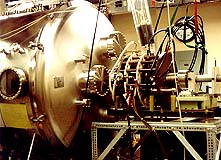| . |  |
. |
 Pasadena - December 13, 1999 - Plasma physicists have long wondered why the geometric shape, or topology, of magnetic fields immersed in plasma sometimes changes very suddenly, when according to the laws of magnetohydrodynamics the magnetic topology should change only very slowly or not at all.
Pasadena - December 13, 1999 - Plasma physicists have long wondered why the geometric shape, or topology, of magnetic fields immersed in plasma sometimes changes very suddenly, when according to the laws of magnetohydrodynamics the magnetic topology should change only very slowly or not at all.For example, according to magnetohydrodynamics, the arched twisted shapes of the beautiful prominences protruding from the sun's surface should stay unchanged for years. Yet it is observed that after a quiescent period of days or weeks, a solar prominence can erupt in a matter of minutes, change its shape drastically, and produce a burst of high-energy particles. The answer is likely in the details, and new research from California Institute of Technology applied physics professor Paul Bellan provides a possible explanation for why seemingly steady magnetized plasma configurations can suddenly become unstable and change their overall shape. The research appears in the December 6 issue of Physical Review Letters.
"The basic prediction of magnetohydrodynamics has been that magnetic fields embedded in plasma tend to be frozen or glued to the plasma because plasma is a very good electrical conductor," says Bellan. "Thus, if the magnetic field moves, the plasma moves in such a way that magnetic field lines cannot slide across the plasma. "This means that the topology is not supposed to change unless the plasma is a less-than-perfect conductor. Yet, in reality, many situations are observed where the magnetic field suddenly becomes unglued, even though the plasma is essentially a perfect conductor." For plasmas immersed in strong magnetic fields, electric currents tend to flow along the magnetic field lines, which act like wires guiding the current. The field-aligned current creates its own magnetic field, and, when added to the original magnetic field, results in a twisted or helical magnetic field. If two such helical magnetic fields happen to be beside each other, like two barber poles lying side by side, there is a sudden change in magnetic field angle at the interface, just like the sudden change in stripe direction in going from one barber pole to its neighbor. "People have worried for many years about what happens in such a situation," Bellan says. "The answer seems to be that the sharp change in magnetic field angle as one moves from one twisted configuration to its similarly twisted neighbor forces a large sheetlike electric current in the interface between the two configurations. "This current sheet consists of electrons moving along the magnetic field. The more abrupt the jump in magnetic field angle, the thinner the current sheet and the faster the electrons move." If the jump in magnetic field angle is big enough, the electrons stream at a speed equal to the propagation velocity of a well-known magnetic plasma wave called the Alfven wave. When the electrons move in sync with the wave, they resonantly interact with the wave and cause it to grow unstably, carrying energy away from the current sheet and so altering the current sheet. "This is interesting because it can rapidly change the magnetic field topology," he says. "So if you push together these two innocent-looking twisted structures, you create an unstable gain mechanism that suddenly generates magnetic waves and so causes a quick, violent change of the magnetic field." In certain situations these waves could also accelerate ions to high energy, a behavior often observed to be associated with sudden changes in magnetic field geometry, but not well understood. Bellan's model could provide improved understanding of such diverse phenomena as solar prominence eruptions; the aurora borealis and aurora australis; and plasma behavior in spheromaks, laboratory devices in which magnetic vortices suddenly break off like smoke rings from specially designed magnetized plasma sources. In short, the new research is a microscopic theory that explains certain puzzling plasma phenomena observed at macroscopic levels. "My theory is a stab at explaining this," Bellan says. "It's not the end answer, but certainly a new twist."
TECH SPACE
|
| |||||||||
| The content herein, unless otherwise known to be public domain, are Copyright 1995-2016 - Space Media Network. All websites are published in Australia and are solely subject to Australian law and governed by Fair Use principals for news reporting and research purposes. AFP, UPI and IANS news wire stories are copyright Agence France-Presse, United Press International and Indo-Asia News Service. ESA news reports are copyright European Space Agency. All NASA sourced material is public domain. Additional copyrights may apply in whole or part to other bona fide parties. Advertising does not imply endorsement, agreement or approval of any opinions, statements or information provided by Space Media Network on any Web page published or hosted by Space Media Network. Privacy Statement All images and articles appearing on Space Media Network have been edited or digitally altered in some way. Any requests to remove copyright material will be acted upon in a timely and appropriate manner. Any attempt to extort money from Space Media Network will be ignored and reported to Australian Law Enforcement Agencies as a potential case of financial fraud involving the use of a telephonic carriage device or postal service. |